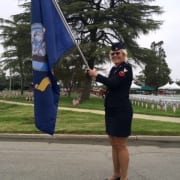Paula Steinbach
Post: North County Post 385
Military Service: U.S. Navy
Member Since: 1974
1. Where and when did you serve in the military?
I enlisted in the Navy in my hometown of Chicago under the delayed entry program in 1973 and reported to Naval Recruit Training Center in Orlando in May of 1974.
After boot camp, I was assigned to Naval Air Station, Memphis.
In Boot Camp, the detailer asked me what I wanted to do in the Navy. I thumbed through the ratings handbook and chose Torpedoman’s Mate. The detailer said angrily, “That’s not open to women yet, but I’ll send you to a base that has a torpedo shop where you learn on the job.”
So he sent me to a naval air station where there wasn’t a torpedo.
While at Memphis, I applied three times for Torpedo School. Twice my request came back, “Request Denied – Rating not open to women.”
Undiscouraged, I applied again and the third time was the charm. The woman Personnel man who had become my friend called me at the barracks. “Paula, you have orders,” she said excitedly, “You’re going to basic electricity school at Great Lakes and then TM school in Orlando.”
I became the third female Torpedoman’s Mate in the Navy.
After finishing my schools, I was sent to the Mark 37 wire guided submarine torpedo shop in Groton, Connecticut.
I stayed there until I re-enlisted for SUBROC school, becoming the first woman to receive this training and finished my enlistment as a TM2 (E5) at Naval Magazine, Guam.
Women were not on ships in my day. My assignments were at shore torpedo intermediate maintenance facilities.
I was always the only woman TM, so I constantly had to prove myself, but I was determined to earn the respect of my male peers. I worked hard and studied diligently for the advancement tests. Finally, when I made E4, I felt I was accepted and had proven to myself and the Navy that women could do anything!
2. Why did you join the military?
I loved military and naval history. The first non-fiction book I read was in 4th grade. It was “The Longest Day” about the D-Day Invasion. From then on, I was hooked. I knew I wanted to be sailor!
3. How did your Jewish faith impact your time in the service?
At Boot Camp, I attended Friday night Shabbat Services. A JWV member was there and signed us all up.
Upon orders to each new base, I contacted the local Jewish community center to find a rabbi and services. I kept Kosher as often as I could. The Jewish Welfare Board provided me with canned kosher food and anything I needed.
Two Jewish Chaplains crossed my paths, Rabbi Bruce Kahn at NAS Memphis and Rabbi Botnick at Great Lakes. They nurtured me, inspired me, and left an indelible spiritual treasury in my life.
4. Have you ever experienced anti-Semitism at home or abroad?
While in the Navy, a thief used to break into my locker and steal my kosher food, but that could have been a statement about my gender, not my ethnicity.
After the Navy, while attending New Mexico State University on the GI Bill, I formed a Hillel group to change the name of the yearbook, which was called Swastika, a supposed reference to Native Americans of the era, but totally unacceptable to us. Our local synagogue, JDL in Denver, and JWV joined us in our fight to change the name. I wrote an article for JWV about the struggle for an issue of “The Jewish Veteran.”
Several times throughout my 30 years of teaching high school history, students have written ethnic slurs and drawn swastikas in their notebooks. I designed a Holocaust course in my district to address this ignorance.
5. Why did you join JWV?
It was a safe and loving place to be Jewish!
6. How would you improve a current JWV program, or what type of program do you think JWV needs to add?
I have no idea which members of my shul in Pomona, CA are veterans. I would like to be able to swap sea stories. Maybe recruiting at synagogues would be good project. I would like to connect nationwide with other female JWV members.
7. What is your favorite Jewish food?
Challah. I am never without it on Shabbat!




